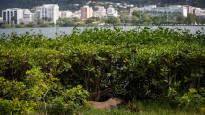The vegetation planted in Guanabara Bay has had numerous positive environmental effects in a short time.
21:58•Updated 22:07
Guanabaran Bay, located in Rio de Janeiro, Brazil, was known for a long time mainly for its polluted and destroyed nature.
During the previous four years, however, 30,000 trees have been planted in the bay, and the area has quickly become a model example of how cities can improve their climate resilience through natural means.
Today, thousands of mangrove trees grow up to four meters high rise from the previously treeless shoreline. Vegetation has had numerous positive environmental effects in a short time.
Mangrove plants that thrive on sea coasts and river estuaries absorb a lot of water and thus slow down the flow of floodwaters into riverbeds in the event of a storm.
In this way, they offer immeasurably valuable protection against floods, which are becoming more common in the world as climate change progresses. At the same time, they act as valuable carbon sinks and stabilize the soil, which would otherwise be washed away with the flood waters.
Plants planted in the bay of Rio de Janeiro have also improved the water quality, which has brought a lot of new marine life to the area. For example, crabs have returned to the area after a long time, which has provided a new livelihood for crabbers.
– Planting a tree in a mangrove is an act for the recovery of the environment and it contributes to the fight against climate change, Ricardo Gomes says news agency AP.
Gomes is one of the leaders of the charity organization responsible for planting the trees.
Although the successful project in Rio de Janeiro has given cause for joy, there have also been darker predictions from Brazil recently. Professor of Global Development Studies at the University of Helsinki Markus Kröger recently told that the loss of rainforests in the southeastern parts of Brazil has already progressed so far that it is difficult to restore the destroyed forest.
Source: AP
